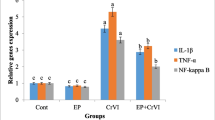Abstract
Diethylnitrosamine (DEN) was used as cancer-inducing agent in the experimental animals.Vinca rosea extract was supplemented with the drinking water as a chemopreventive agent. After 4 wk of treatment, animals were sacrificed and livers were excised. Nuclei and mitochondria were separated by differential centrifugation. The proton-induced X-ray emission technique has been used as the analytical method. Elemental analysis were performed for whole liver, nuclei, and mitochondria.V. rosea plant parts were also analyzed for elemental contents. Treatment with DEN caused an increase of Ni, Zn, and Cr levels in the whole liver and nuclei. There is an increase in Fe concentration in the liver, although the level decreased in mitochondria. The concentrations of Br and Ca were unchanged in the liver as a whole, but there were substantial increases of Br in nuclei and mitochondria, whereas Ca levels depleted drastically in these two organelles.Vinca extracts were effective in reverting the changes in the elemental concentration in the hepatic tissue as a whole, but were not that effective at subcellular levels.
Similar content being viewed by others
References
D. Thurnher, D. Turhani, M. Pelzmann, et al., Betulinic acid: a new cytotoxic compound against malignant head and neck cancer cells,Head Neck 25, 732–740 (2003).
R. L. Noble, The discovery of the vinca alkaloids–chemotherapeutic agents against cancer,Biochem. Cell Biol. 68, 1344–1351 (1990).
W. Yalin, O. Ishurd, S. Cuirong, and P. Yuanjiang, Structure analysis and antitumor activity of (1→ 3)-β-D-glucans (cordyglucans) from the mycelia ofCordyceps sinensis, Planta Med. 71, 381–384 (2005).
A. Tangeras, Lysosomes, but not mitochondria, accumulate iron and porphyrins in porphyria induced by hexachlorobenzene,Biochem. J. 235, 671–675 (1986).
H. W. Kuo, S. E Chen, C. C. Wu, D. R. Chen, and J. H. Lee, Serum and tissue trace elements in patients with breast cancer in Taiwan,Biol. Trace Element Res. 89, 1–11 (2002).
A. Lupulescu,Cancer Cell Metabolism and Cancer Treatment, Harwood Academic, Amsterdam, pp. 10–12 (2001).
J. A. Buege and S. D. Aust, Microsomal lipid peroxidation,Methods Enzymol. 52, 302–310 (1978).
T. P. M. Akerboom and H. Sies, Assay of glutathione disulfide, and glutathione mixed disulfide in biological samples,Methods Enzymol. 77, 373–382 (1981).
H. Aebi, Catalase in vitro,Methods Enzymol. 105, 121–126 (1984).
O. H. Lowry, N. J. Rosebrough, A. L. Farr, and R. J. Randall, Protein measurement with folin phenol reagent,J. Biol. Chem. 193, 265–275 (1951).
S. A. E. Johansson and J. L. Campbell,PIXE: A Novel Technique for Elemental Analysis, Wiley, New York (1998).
M. Sudarshan, R. K. Dutta, V. Vijayan, and S. N. Chintalapudi, PIXE measurements of drinking water of Salt Lake, Calcutta, India,Nucl. Instrum. Methods B 168, 553–558 (2000).
K. Doreswami, B. Shrilatha, T. Rajeshkumar and Muralidhara, Nickel-induced oxidative stress in testis of mice: Evidence of DNA damage and genotoxic effects,J. Androl. 25, 996–1003 (2004).
S. Toyokuni, Iron-induced carcinogenesis: the role of redox regulation,Free Radical Biol. Med. 20, 553–566 (1996).
S. Lynn, E H. Yew, J. W. Hwang, M. J. Tseng, and K. Y. Jan, Glutathione can rescue the inhibitory effects of nickel on DNA ligation and repair synthesis,Carcinogenesis 15, 2811–2816 (1994).
L. A. Poirier, The effects of diet, genetics and chemicals on toxicity and aberrant DNA methylation: an introduction,J. Nutr. 132, 2336S-2339S (2002).
Y.-W. Lee, C. B. Klein, B. Kargacin, et al., Carcinogenic nickel silences gene expression by chromatin condensation and DNA methylation: a new model for epigenic carcinogenesis,Mol. Cell. Biol. 15, 2547–2557 (1995).
K. S. Kasprzak and R. M. Bare, In vitro polymerization of histones by carcinogenic nickel compounds,Carcinogenesis 10, 621–624 (1989).
M. Kucharzewski, J. Braziewicz, U. Majewska, and S. Gozdz, Selenium, copper and zinc in intestinal cancer tissue and in colon rectum polyps,Biol. Trace Element Res. 92, 1–10 (2003).
R. G. Uzzo, P. Leavis, W. Hatch, et al., Zinc inhibits nuclear factor-κB activation and sensitizes prostate cancer cells to cytotoxic agents,Clin. Cancer Res. 8, 3597–3583 (2002).
K. Salnikow, M. Gao, V. Voitkun, X. Huang, and M. Costa, Altered oxidative stress responses in nickel-resistant mammalian cells,Cancer Res. 54, 6407–6412 (1994).
H. Cunzhi, J. Jiexian, Z. Xianwen, G. Jingang, Z. Shumin, and D. Lili, Serum and tissue levels of six trace elements and Cu/Zn ratio in patients with cervical cancer and uterine myoma,Biol. Trace Element Res. 94, 113–122 (2003).
J. M. McCord, Iron, free radicals and oxidative injury,Semin. Hematol. 35, 5–12 (1998).
M. G. Simic, Mechanisms of inhibition of free-radical processes in mutagenesis and carcinogenesis,Mutat. Res. 202, 377–386 (1988).
S. D. Flora, Threshold mechanisms and site specificity in chromium(VI) carcinogenesis,Carcinogenesis 21, 533–541 (2000).
D. Y. Cupo and K. E. Wetterhahn, Binding of chromium to chromatin and DNA from liver and kidney of rats treated with sodium dichromate and chromium(III) chloride in vivo,Cancer Res. 45, 1146–1151 (1985).
S. K Tandon, J. R. Behari, and D. N. Kachru, Distribution of chromium in poisoned rats,Toxicology 13(1), 29–34 (1979).
M. Pas, R. Milacic, K. Draslar, N. Pollak, and P. Raspor, Uptake of chromium(III) and chromium(VI) compounds in the yeast cell structure,Biometals 17(1), 25–33 (2004).
R. L. Messer and L. C. Lucas, Localization of metallic ions with gingival fibroblast subcellular fractions,J. Biomed. Mater. Res,59(3), 466–472 (2002).
M. A. Fernandes, M. S. Santos, M. C. Alpoim, V. M. Madeira, and J. A. Vicente, Chromium(VI) interaction with plant and animal mitochondrial bioenergetics: a comparative study,J. Biochem. Mol. Toxicol. 16(2), 53–63 (2002).
D. D. Hepburn and J. B. Vincent, Tissue and subcellular distribution of chromium picolinate with time after entering the bloodstream,J. Inorg. Biochem,94(1–2), 86–93 (2003).
M. A. Sipowicz, L. M. Anderson, W. E. Utermahlen, Jr., H. J. Issaq, and K. S. Kasprzak, Uptake and tissue distribution of chromium(III) in mice after a single intraperitoneal or subcutaneous administration,Toxicol. Lett. 93(1), 9–14 (1997).
W. J. Marshal and S. K. Bangert,Clinical Biochemistry, 2nd ed., Churchill Livingstone, New York (1995).
Author information
Authors and Affiliations
Rights and permissions
About this article
Cite this article
Mohanta, B., Sudarshan, M., Boruah, M. et al. Potential ofVinca rosea extracts in modulating trace element profile. Biol Trace Elem Res 117, 139–151 (2007). https://doi.org/10.1007/BF02698090
Received:
Revised:
Accepted:
Issue Date:
DOI: https://doi.org/10.1007/BF02698090




